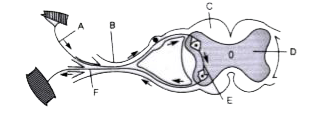Complete Solutions to SECTION-II of chapter SAMPLE QUESTION PAPER 4 of Class 10 book with complete answers and questions
| Class 10 | BIOLOGY |
| Chapter | SAMPLE QUESTION PAPER 4 |
| OSWAL | SECTION-II |
| Number Of Questions | 12 |
| Academic Year | 2023-24 |
The diagram given below represents a certain stage of mitosis :

Identify the stage of cell division.
View SolutionName the hormones which lead to the following conditions.
(i) Diabetes mellitus
(ii) Growth of beard in women
(iii) Myxoedema
(iv) Gigantism
(v) Exophthalmic goiter
View SolutionThe given diagram is highly diagrammatic representation of mammalian heart. In this diagram
Name the parts marked 1-12.

View SolutionCopy and complete the following by filling in the blanks 1 to 5 with appropriate words/terms/ phrases:
To test the leaf for starch, the leaf is boiled in water…….(1) It is next boiled in methylated spirit to……(2)The leaf is placed in warm water to soften it. It is then placed in a dish and ......... (3) solution is added. The region, which contains starch, turns...(4)and the region, which does not contain starch, turns ...... (5)
View SolutionThe diagram below represents an experiment to demonstrate a particular aspect of a physiological process in plants. Study the diagram and answer the questions that follows:

Explain the term Destarching.
View SolutionComplete the following paragraph by filling in the blanks (1) to (V) with appropriate words:
The amount of urine output is under the regulation of a hormone called (i)___________ secreted by the (ii)__________lobe of the pituitary gland. If this hormone secretion is reduced, there is an increased production of urine. This disorder is called (iii)__________ . Sometimes excess glucose is passed with urine due to hyposecretion of another hormone called (iv) __________ leading to the cause of a disease called (v)__________
View SolutionThe diagram given below is that of a structure present in a human kidney. Study the same and answer the questions that follows :

(i) Name the structure represented in the diagram.
(ii) What is the liquid entering part T called? Name two substances present in this liquid that are reabsorbed in the tubule.
(iii) What is the fluid that comes to part '2' called? Name the main nitrogenous waste in it.
(iv) Mention the three main steps involved in the formation of the fluid mentioned in (iii) above.
(v) Name the substance which may be present in the fluid part '11 if a person suffer from diabetes mellitus.
View SolutionGiven below is an example of certain structures and their special functional activities. For example: Eye and vision. On a similar pattern, complete the following:
(i) Neutrophils:
(ii) Ureter:
(iii) Neurotransmitters:
(iv) Iris of the eye:
(v) Placenta:
View SolutionA potted plant with variegated leaves was taken in order to prove a factor necessary for photosynthesis. The potted plant was kept in the dark for 24 hours and then placed in bright sunlight for a few hours Observe the diagrams and answer the questions.

What aspect of photosynthesis is being tested in the above diagram?
View SolutionChoose between the two options to answer the question specified in the brackets for the following:
An example is illustrated below :
Example : Corolla or Calyx (Which is the outer whorl ?) Answer : Calyx
(i) Blood in the renal artery or renal vein (Which one has more urea ?)
(ii) Perilymph or endolymph (Which one surrounds the organ of Corti ?)
(iii) Lenticels or stomata (Which one remains open always?)
(iv) Sclerotic layer or choroid layer (Which one forms the Iris?)
(v) Blood in the pulmonary artery or pulmonary vein (Which one contains less oxyhaemoglobin?)
View SolutionThe diagram given below is a representation of a phenomenon pertaining to the nervous system. Study the diagram and answer the following questions:

(i) Name the phenomenon that is being depicted.
(ii) Give the technical term for the point of contact between the two nerve cells.
(iii) Name the parts A, B, C and D.
(iv) Write the functions of parts E and F.
(v) How does the arrangement of neurons in the spinal cord differ from that of the brain.
View Solution(b) Mention the exact location of the following:
(i) Proximal convoluted tubule.
(ii) Lacrimal gland
(iii) Malleus
(iv) Hydathodes
(v) Semilunar valve
View Solution
SECTION-II questions and complete solutions for chapter SAMPLE QUESTION PAPER 4 of EVERGREEN BIOLOGY (ENGLISH) of Class 10